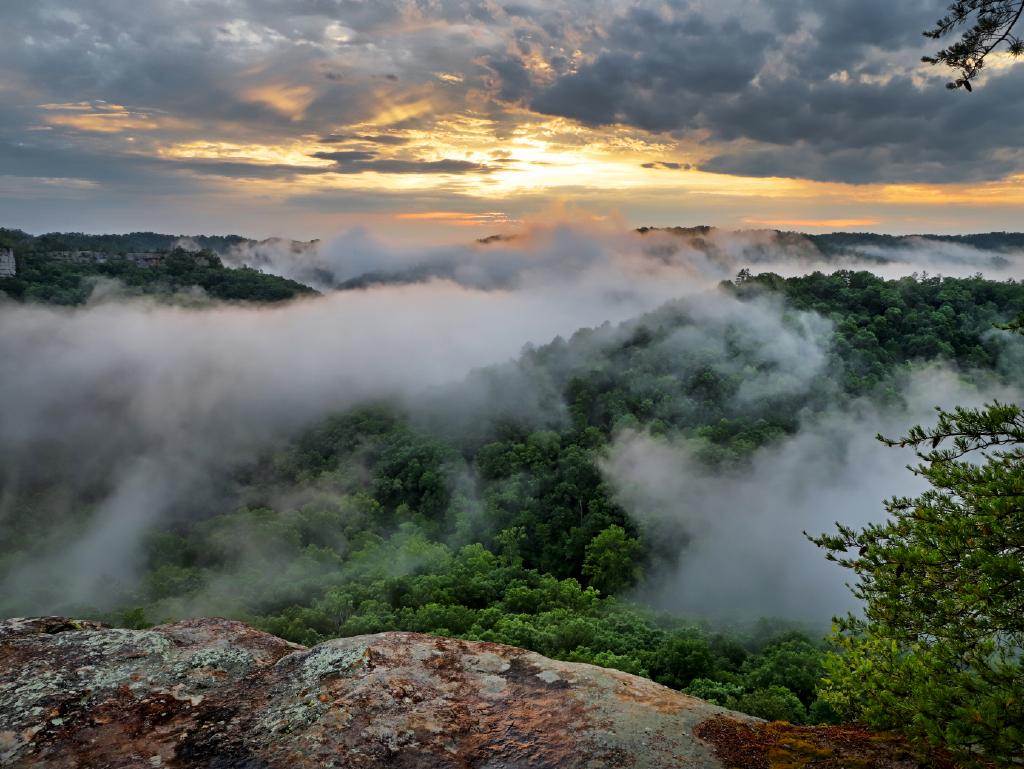8 Reasons Why Kentucky is an Amazing Place for Outdoor Lovers
State Wide
There are plenty of reasons to visit Kentucky. It isn’t all horse racing, bourbon distilleries, and bluegrass music—although it’s got all three in abundance. Kentucky’s incredibly diverse array of geological features and ecosystems means it offers opportunities for all your favorite outdoor activities, too.
Whether you’re looking for an adventure on the water, on land, or underground, Kentucky has it all. Here are eight reasons to take your next trip to the Bluegrass State.
1. OVER TWO MILLION ACRES OF NATIONAL FORESTS
Take supplies and a map on your Kentucky adventures. Kentucky plays host to two separate national forests, totaling over 2 million acres of public land. Land Between the Lakes National Recreation Area, sandwiched between Kentucky Lake and Lake Barkley, encompasses the largest inland peninsula in the United States. Daniel Boone National Forest, whose 2 million-plus acres make up the bulk of the USDA-managed land, is named for the famed 18th-century frontiersman, whose exploration made settlement in Kentucky largely possible—and the terrain there is as rugged as its namesake.
2. MORE NAVIGABLE WATERWAYS THAN ANY OTHER STATE IN THE LOWER 48
Kentucky has more miles of running water than any state in the lower 48. All its rivers and tributaries eventually make their way to the Mississippi River and there’s no shortage of adventure to be had on the 1,100 miles of navigable water. Nine of Kentucky’s countless waterways, totaling 114 miles, are designated as Kentucky Wild Rivers, meaning they’ll never be developed or impeded upon. Serious whitewater paddlers can find gnarly Class IV rapids on the Big South Fork River and mellow flatwater on the Cumberland.
3. THE LONGEST CAVE SYSTEM IN THE WORLD
Kentucky's Mammoth Cave by far the largest known cave system in the world. Mammoth Cave blows its competition out of the water and explorers continue to map more of its wonders every year. The 405 miles of explored passageways mean it’s more than twice the size of the second-longest known cave, the underwater Sac Actun in Mexico.
Officially known as the Mammoth-Flint Ridge Cave System, this sandstone-capped limestone strata behemoth is a UNESCO World Heritage Site. It also lies within a national park (Mammoth Cave National Park). Visitors can check out the cave with a knowledgeable guide.
4. WORLD-CLASS ROCK CLIMBING
The Red River Gorge is a climbing hot spot. Ask any climber to name a few destinations on their bucket list and you’re bound to hear about the iconic Red River Gorge. The Red, as it’s affectionately known, is home to over 1,500 established routes, mostly long, overhung, single-pitch sport—though there’s some high-quality trad climbing to be had, too. Climbing access issues have eased considerably in the last decade, thanks to dedicated advocacy groups. These days, your biggest access issue will be getting a seat at world-famous Miguel’s Pizza.
5. THE NIAGARA FALLS OF THE SOUTH
Look for the moonbow at Cumberland Falls. With all those waterways, it’s no surprise that Kentucky is home to tons of waterfalls but its most beloved is Cumberland Falls. The 68-foot waterfall—that’s seven stories—spans the length of the Cumberland River, and on clear nights under a full moon, you might just catch a glimpse of the elusive moonbow. The surrounding Cumberland Falls State Resort Park is also home to miles of hiking trails, tons of wildflower species, and, of course, plenty of swimming and paddling.
6. GEOLOGY ROCKS

Curious geological structures are found throughout the state. Pun intended: Kentucky’s diverse geology means science geeks (and outdoor adventurers) will have plenty to keep them busy. The Cumberland Plateau region is home to one of the country’s highest concentrations of natural arches, created by millions of years’ worth of water erosion in soft sandstone. And that’s just above ground—Kentucky’s unique geological makeup means Mammoth isn’t the only cave. Check out a ranger-led tour of the Gap Cave, or, for more experienced cavers, explore caves open to the public on your own.
7. COUNTLESS ADVENTURE BASECAMPS
Trail Towns connect visitors to trails, outfitters, food and lodging. Established in 2012, Kentucky’s Trail Towns program helps communities "connect the dots for travelers," guiding outdoorsy types to trails, food, lodging, campgrounds, and other adventure necessities. Trail Towns are strategically located on long distance trails—both hiking trails and rivers systems open to canoeing and kayaking—and connect folks to outfitters, retailers, affordable lodging, and informational materials. So far, 20 towns have earned the distinction.
8. SIX NATIONAL PARK SERVICE UNITS
The National Park Service manages more than its famous parks, it also oversees sites of cultural and historical significance. Sure, it’s got Mammoth Cave National Park and Big South Fork National River and Recreation Area, which fall into the latter category. But Kentucky is also home to four other NPS sites: the birthplace and boyhood home of Abraham Lincoln, a Civil War battlefield and cemetery, the Cumberland Gap in the Appalachian Mountains, and the Trail of Tears National Historic Trail, which commemorates a painful but significant chapter of American history. From hiking to spelunking, each of these units offers a chance to combine outdoor recreation with America’s rich history.